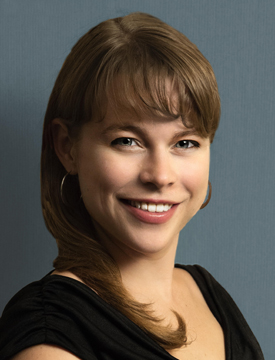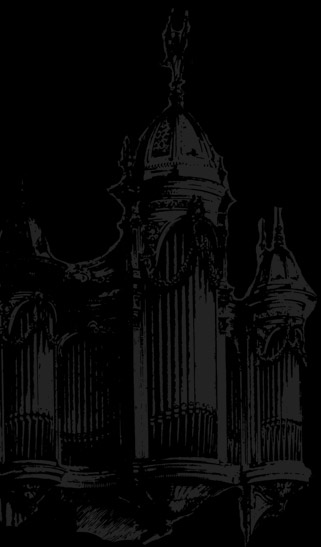Katelyn Emerson
| Biography | Hi-Res Photo |
| Press Notices | Personal Website |
| Discography |
With her busy concertizing and teaching schedule throughout the United States, Europe, and Asia, Katelyn Emerson is known as both “a star of the first rank, and an ambassador for the organ” (Orgue Canada). A prizewinner of competitions on three continents, Katelyn’s stellar performances and warm personality garner acclaim from listeners new to classical music and organ aficionados alike. With innovative programs, custom-made for each instrument, and deeply personal interpretations, Katelyn and the organ are true partners in music-making.
RECORDING REVIEWS:
“This is another top-drawer recording from one of our brightest rising stars. Indeed, “rising star” may no longer apply: Katelyn Emerson is already well above the horizon, shining brilliantly. One trusts that a long and unclouded day stretches before her. Inspirations is a joy to listen to, as well as a wonderful study in programming, interpretation, and registration. Artist, instrument, repertoire, and production come together in one 76-minute-long triumph.
Emerson knows how to grab your attention at the very first moment of a piece … With every track on this CD, one knows, immediately, that [she] has something to say, and knows how to say it, and why …
There are no gimmicks, no conceptual agendas to deal with. There is just the music, running joyously …”
The American Organist, June 2020
… Katelyn Emerson has taken the organ world by storm. I do not know anyone, myself included, who has heard her play and has not been impressed …
… Katelyn Emerson’s program notes in the leaflet … are refreshingly original and interesting.
It ought not come as a surprise that I thoroughly enjoyed and heartily recommend this compact disc.”
The Diapason, June 2019
CONCERT REVIEWS:
Düsseldorf
Headline: “Katelyn Emerson Reaches for the Stars”
“The American organist performed at St. Lambertus Basilica. Her program, entitled “Per aspera ad astra,” offered a repertoire that was as rare as it was captivating.
…Emerson’s selection of music, spanning from the 19th century to the present day, was not part of the frequently performed repertoire. Her extensive European experience proved invaluable in compiling the program…
Her organ playing, from the first note to the final chord, aimed for a breathtaking sweep of sound. Behind her concept, however, lay a very thoughtful, by no means superficial, approach to the music. Technically, Emerson knows no bounds.
Although only 21 years old, the “Étude Héroique” by Canadian composer Rachel Laurin’s harmonic, formal, and thematic roots were firmly planted in the 19th century. After an almost overwhelming opening, there were strong contrasts—for example, to elements reminiscent of whistling and dancing instrumental music. The equally multifaceted “Sonata Eroica” by Belgian composer Joseph Jongen, which concluded the program, provided a fitting counterpart. It culminated in a fugue before the rousing final section, which even employed glissandi on the manuals.
And yet, Emerson gave both of the more assertive pieces moments of repose, allowing the tension to develop and unfold. She also utilized the spatial arrangement of the organ works in the church, so that their movement through the space could be followed. In the shorter Scherzo by Marco Enrico Bossi, Katelyn Emerson’s precise and nimble fingers were a sight to behold. In the confined space, she also allowed the sonic climaxes to blossom and fade away with equal speed.”
Reinische Post, 4 November 2025, Norbert Laufer
Glasgow
“… I would love to list all the inspired and revelatory timbral choices that illuminated the Bach masterpiece [Katelyn’s transcription of the Chaconne in D-minor Partita No.2 for solo violin] but I’ll restrict myself to a handful: scampering bassoons for some G-string runs, rippling reed arpeggiation for some string-crossing passages, hushed flutes and viole for the prayerful start of the major-key central section and trumpets at its climax before the minor is reasserted. Fabulous building of chromatic tension right through to the final Tierce de Picardie. Superb … The recital was very well-received and the applause was fulsome …” Donal Hurley, Edinburgh Music Review, Sept. 2025
Madrid
“Rachel Laurin’s neo-romantic aesthetics (actually, full-blown romantic) in her Fantasy and Fugue in D Major sparkled in the fluent interpretation of Katelyn Emerson at the organ of the Sala Sinfónica of the Auditorio Nacional de Música …”
RITMO, December 2023
“The Brombaugh brilliantly showcased early music … Recitalist Katelyn Emerson proved that such an instrument is also broad enough in its colors and abilities to render Bach and Mendelssohn compellingly. Emerson’s precise articulations, sparkling runs, and sensitive interpretations were a perfect match for the organ and venue.”
The American Organist, October 2022
“The new Fritts organ in First Lutheran Church was officially welcomed … with a far-ranging program impressively played by Katelyn Emerson. Absent any liquid bubbly, there was plenty of musical effervescence to delight a crowd that overflowed into the adjacent space and required more programs to be distributed during intermission.
… Emerson revealed the beauty and versatility of the instrument in compromising works by Vincent Lübeck, J.S. Bach, and Georg Muffat, leavening their serious-mindedness with music by Frank Bridge and Bernardo Pasquini.
The recital ended with J.S. Bach’s imaginative [sic]– and early — Toccata in E, a 1708 work in four sections that gave both organ and organist the opportunity to go out in a burst of musical brilliance.
A long, rousing ovation inspired Emerson to add a brief extra work to the mix. Just in case she had left any sounds unheard, she chose some of the instrument’s more piquant registers for her performance of Jean Langlais’ witty “Thème et variations” from Hommage à Frescobaldi.”
Clevelandclassical.com, August 2019
“Boston’s Historic Park Street Church made a felicitous decision when it chose Katelyn Emerson for the recital celebrating the near completion of the church’s 1960 Aeolian-Skinner’s full restoration … she tailored her selections to the instrument, keeping her pair of stop-pullers busy making myriad changes of combinations to show off as many different tone-colors as possible … Emerson spoke with poise, enthusiasm, and considerable knowledge about both the works played and this organ’s history.
… powerfully theatrical, with multiple opportunities to highlight the grandeur of full organ, generate tension … create power and mystery via the swell shades, and of course, display considerable virtuosity. Emerson did all this handily in an electrifying account.”
Boston Music Intelligencer, March 2019
“Katelyn Emerson is a star of the first rank already, and an ambassador for the organ with a very bright future, indeed.”
Orgue Canada, Autumne 2017
“Katelyn Emerson’s demonstration of the Mother Church organ [Boston, MA] really blew us away. Not in the least afraid of this 242-rank instrument, she commanded every bit of it with a careful ear and sense of musicality that puts her at the top of recitalists performing today.”
Journal of American Organbuilding, November 2016
“… first prize-winner of this year’s NYACOP, Katelyn Emerson, who gave a stunning recital at St. Paul’s United Methodist Church the day before the convention. Her strong background in historical performance was evident in the Buxtehude D-minor Praeludium, B[ux]WV 140, which she interpreted stylishly despite the organ’s antithetical aesthetic. Her playing demonstrated a strong command of rhythm and wonderful sense of pacing, whether in the lilting flow of Vierne’s Naïades or in the rhetorical flourishes of Tournemire’s Victimae paschali. A highlight of Emerson’s program was Thierry Escaich’s Evocation (2008), which she interpreted with great sensitivity, shaping its minimalist textures into compelling phrases. Her expert handling of the organ was apparent throughout, especially in the lyrical lines of Frank Bridge’s Adagio and in the first movement of Dupré’s Symphonie II in C-sharp minor, which concluded the program with exciting artistry.”
The American Organist, Sept. 2016
“Emerson … shows every indication that she will become one of her generation’s most prominent organists.”
“Emerson is an assured, thoughtful interpreter whose strength lies in an ability to marshal the power of seemingly opposing qualities. She conveyed the excitement within the works she played … by taking a calm, reasoned approach and allowing the music’s tensions to build without overstatement. Her approach to coloration is subtle, rather than showing, yet … she draws widely on the instrument’s resources, and she is not afraid of a true pianissimo.”
“Perhaps most crucially, in works as varied as Herbert Howells’ Rhapsody (Op. 17, No. 3), Jehan Alain’s Litanies (JA 119) and Mozart’s Fantasia (K608), she focused on the music’s heft and breadth, yet within the sweep of her readings, she did full justice to the works’ considerable intricacies.”
Allan Kozinn, Portland Press Herald, August 2016
“… Katelyn Emerson dazzled …”
The American Organist, Sept. 2014
“… exciting and musical playing … I feel encouraged about the future of the organ returning to the forefront as a recital instrument. You are certainly a rising star.”
L’Organo, June 2014
“Amazing, incredible, and inspiring were just some of the adjectives I heard our members use to describe [Katelyn’s] seemingly effortless performance.”
Lexington Chapter of The American Guild of Organists, October 2012








